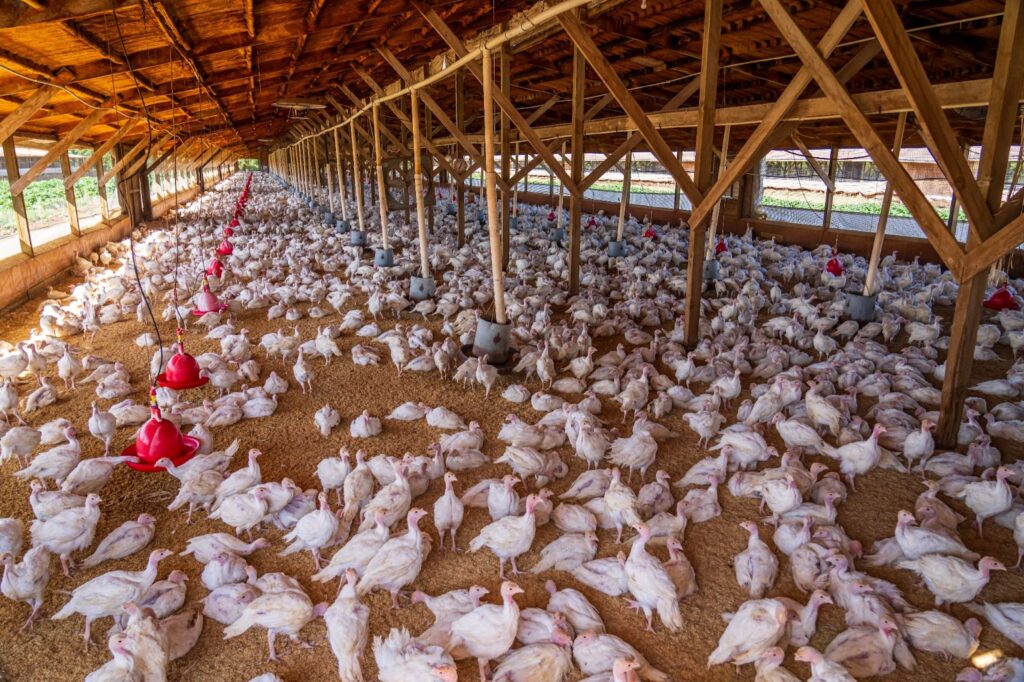
Your chickens need the perfect environment to thrive and be healthy. But it takes a lot of energy to create that environment.
With broiler sheds housing between 20,000 – 50,000 birds, the cost of energy can significantly impact your bottom line.
Relying on fossil fuels for your energy has some serious drawbacks. You’re beholden to the prices utility companies decide to charge, and you’re vulnerable to blackouts and supply shortages.
All of these things can have serious consequences on the profitability and sustainability of a poultry farm.
Solar energy changes all of that. Imagine having a limitless, abundant – and most importantly – (almost) free power supply for your feathered friends.
Here’s how solar energy can benefit your poultry farm in Colorado.
In a Nutshell
- Solar energy can reduce a poultry farm’s electricity bills by up to 96%.
- With solar, you get a reliable and consistent power source, making your farm power resilient.
- Utility companies will keep raising their prices. Solar energy protects your farm from these price hikes.
- Over 80% of a poultry farm’s carbon emissions come from electricity use. Solar can, therefore, significantly reduce your carbon footprint.
- Over 40% of consumers in the mid-west are willing to pay more for sustainably produced food products.
How Does Solar Energy Benefit a Poultry Farm?
Reduced Energy Bills

According to a report by the University of Arkansas, energy expenditure is a poultry farm’s second-largest expense after mortgages and this expense is rising year on year.
The report notes that electricity consumption ranges from 20 to 83 kWh per 1,000 pounds of broiler sold. This is a wide range and has everything to do with any existing energy efficiencies you’ve made to your farm.
Broiler houses need a lot. They rely on electricity for:
- Automated feed lines and watering systems
- Lighting
- Ventilation
- Cooling systems during the hot months and heating systems in the colder months
Whether you have taken energy efficiency measures or not, we’re sure your electricity bill is much higher than you’d like it to be.
Getting solar for your poultry farm can significantly reduce this cost. With a correctly sized solar system, the savings can be as much as a 96% reduction on your energy bill.
Let’s take a look at some examples:
- A $5,000 monthly energy bill could be reduced to $200
- A $10,000 monthly energy could be reduced to $400
- A $15,000 monthly energy bill could be reduced to $600

The amount you can reduce your energy bills by has everything to do with the amount of energy your solar panels can produce. Fortunately, Colorado enjoys over 300 days worth of sunshine each year and is one of the sunniest states in the US.
Abundant sunshine, coupled with its cooler climate, provides the perfect environment for your solar panels to work at maximum efficiency!
Energy Resilience

Colorado’s grid-based energy supply is on shaky ground. Heatwaves, wildfire risks, and the steady influx of people arriving in the state are placing extra pressure on the grid.
Furthermore, Colorado’s grid infrastructure is old, and with the planned closure of all its coal plants, it’s going to be stretched even further.
The outcome of all of this will be rolling blackouts. To understand the impact of these, you just need to look at the chaos experienced in Texas when most of the state lost power for days following extreme weather in 2021.
Ask yourself this, “How many days can your poultry farm suffer without power before it has a devastating economic impact on your business?”
When you rely on the grid for your power, you are vulnerable to any losses it experiences. As you’ve probably guessed, solar energy doesn’t have the same issues.
Since you can rely on the sun to be present each and every day (solar panels still harvest energy when there is cloud cover), you can subsequently rely on having a supply of electricity.
This gives you resilience and immunity from grid outages and ensures you have a stable and reliable power source whenever you need it.
To build on your resilience, you can invest in solar batteries. These store the excess power your solar panels produce during the day, which you can then use when the panels aren’t producing energy (like at night). Doing this gives you full energy independence and even allows you to operate 100% off-grid.
Immunity From Energy Cost Increases

Utility companies seem to be able to do what they want with little to no recourse. Xcel is a notorious example of this and has made its customers miserable these past couple of years with its exorbitant price hikes.
Xcel has raised its prices by an eye-watering 38% since 2019 despite making killer profits, and if you get your power from them you’ll have noticed your bill increased by another 4.4% in September 2023. That’s AFTER it already raised its prices by over 4% at the start of the year.
For an energy-intensive farm, these numbers are significant but the problems don’t end there. If prices continue on the upward trajectory – which they are likely to – you’ll be paying around 30% more for your energy bills ten years down the line.
According to our research, this is what your bills could look like – and bear in mind that these are conservative estimates:
- A $5,000 monthly bill in 2023 could rise to over $58,000 annually in 2033 and to over $70,000 annually by 2040;
- A $10,000 monthly bill in 2023 could rise to over $167,500 annually in 2033 and to over $200,000 annually by 2040;
- A $15,000 monthly bill in 2023 could rise to over $251,295 annually in 2033 and to over $300,757 annually by 2040.
Shocked? You should be!
Fortunately, solar energy provides an escape from ever-spiraling costs. We’ve already demonstrated how solar can reduce your energy bills by over 90%, but you also have to consider that solar panels enjoy incredible longevity.
Most panel warranties are for 25 years but the reality is that if they are well looked after, they can last much longer. Although they experience a slight drop in efficiency over time, many panels will last up to and beyond 30 years.
And when they do reach the end of their life, the cost of replacing them will be substantially lower than the amount you have saved over the years in energy costs.
A Lower Carbon Footprint

The Biden administration is pushing for a clean energy future and sooner or later you’re going to have to get on board. Besides, we all want to ensure our planet is left in a good state for future generations to enjoy.
While poultry farming certainly isn’t the worst offender when it comes to carbon emissions (that’ll be beef and dairy farming), it still produces a lot and is responsible for 0.6% of all agricultural emissions.
According to a 2015 research study, 83% of mechanical greenhouse gas emissions from poultry breeder farms came from electricity use. For broiler and pullet farms relying on propane gas for energy, this figure rose to 96%.
Therefore, by investing in solar energy, you can reduce almost all of your carbon footprint in one fell swoop and contribute to a cleaner and greener future.
Attract More Customers

This is an interesting one. As consumers become more aware of the environmental impact of food production, they are starting to demand more sustainably produced choices. Moreover, customers are actually willing to pay more for sustainable products.
A survey by Statista revealed that 43% of consumers living in the Midwest US were willing to pay more for sustainability. This trend continues across other areas of the USA and ranges from 41% to 49%.
So, not only will solar energy save you money on your energy bills, but it also means you can potentially charge more for your poultry products. We’ll call that a win-win situation!
Solar Energy for Poultry Farms: Talk to 8760 Solar

The best thing about solar energy – besides the cost savings, of course – is that it’s incredibly versatile and can be placed anywhere there is clear space and access to sunlight.
If you have a number of broiler sheds, then the roofs of these can be the perfect place to install your panels and won’t take up valuable space elsewhere.
8760 Solar can help you determine the ideal spot for your solar panels as well as what type and size of system you need to power your farm. We do this by running a thorough analysis of your property and then talking to you about your energy needs.
We will also make you aware of all the current solar incentives and grants available. For example, did you know you can apply for a REAP grant, which can cover up to 50% of the cost of your installation? This is on top of the 30% ITC tax credit you can claim for going solar.
In all, the available incentives mean it’s more than possible to get over 100% return on investment in the first year that your solar system is operational. Just talk to our team and we’ll be happy to explain how.
If you’re ready to go solar, then we’re ready to talk to you! Text “READY” to 719 470-0254 or contact us via email: sales@8760solar.com. We’ll be in touch right away.
Frequently Asked Questions
Is It Safe to Install Solar Panels on a Chicken House Roof?
It is safe to install solar panels on a chicken house roof as long as the roof is sturdy enough and structurally sound to take the weight of the installation. A general rule of thumb is that the roof must be less than 40 years old and can accommodate 2-6 pounds per square foot.
How Does Solar Energy Help the Animals?
Solar energy helps farm animals by ensuring there is a continuous supply of electricity available to run the systems required to keep the animals comfortable. Grid energy is vulnerable to blackouts which can have a detrimental effect on the animal’s welfare. With solar energy, this problem is removed.
How Do Solar Panels Affect Farmland?
There is no evidence to suggest that solar panels negatively affect farmland besides taking up space. Conversely, the microclimate generated beneath solar panels is very beneficial and helps keep the ground cooler while maintaining soil moisture and reducing soil erosion.
How Much Energy Does a Chicken Farm Use?
A chicken farm consumes between 20 to 83 kWh per 1,000 pounds of broiler sold. The range in power consumption is down to any energy efficiency steps the farm may have taken to reduce electricity consumption such as insulating broiler sheds, sealing drafty areas, and replacing ventilation and heat lamps for energy-efficient alternatives.
